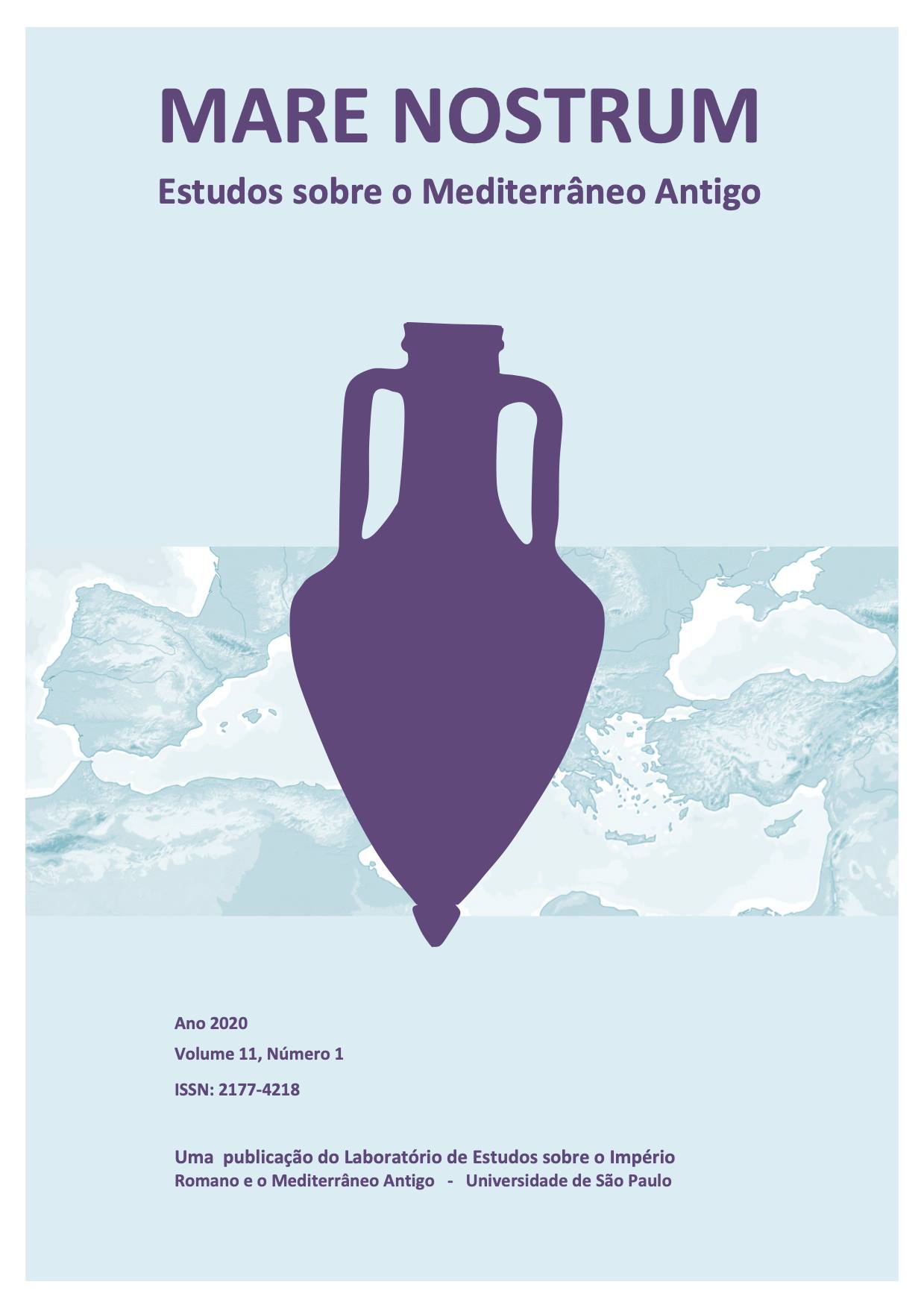Mudanças climáticas e a construção de cisternas micênicas (1300 a.C.-1200 a.C.)
DOI:
https://doi.org/10.11606/issn.2177-4218.v11i1p351-376Palavras-chave:
Mediterrâneo, mudanças climáticas, paleoclima, micênicos, cisternasResumo
Esse artigo aborda a discussão de dados paleoclimáticos no tocante ao final da Idade do Bronze (1300 a.C.-1200 a.C) no Mar Mediterrâneo e sua possível relação com o surgimento de estruturas de captação subterrânea de água (syrinx) em cidadelas micênicas da Argólida. Os dados paleoclimáticos têm sugerido que houve uma diminuição na temperatura desse mar e um consequente período de estiagem. Com base na discussão dos dados paleoclimáticos, vestígios arqueológicos e fontes escritas que tratam da diplomacia no período, analisaremos o modo pelo qual a instabilidade geopolítica e a estiagem podem ter motivado a construção de cisternas subterrâneas em cidadelas micênicas na Argólida.
Downloads
Referências
Aristóteles, (n.d.). Meteorologica. (H. Lee, trad.). Cambridge University Press.
Bar-Matthews, M. & Avner, A. (2004). Speleothems as palaeoclimate indicators, a case study from Soreq Cave located in the Eastern Mediterranean Region, Israel. In R. Battarbee et al. (Eds) (2004). Past Climate Variability through Europe and Africa. Kluwer Academic Publishers.
Bordreuil, P.,(Ed.) (1991). Une bibliothèque au sud de la ville: Les textes de la 34ecampagne(1973). Ras Shamra-Ougarit VII. Éditions Recherche sur les Civilisations.
Braudel, F. (1998). Memorias del Mediterráneo: Prehistoria y antigüedad. Ediciones Cátedra.
Bryson, R., Lamb, H. & Donley. D. (1974). Drought and the Decline of Mycenae. Antiquity,48(189), 46–50.
Carpenter, R. (1966). Discontinuity in Greek Civilisation. Cambridge University Press.
Cline, E. (2014). 1177 B.C.: The year civilization collapsed. Princeton University Press.
Cline, E. (Ed.) (2010). The Bronze Age Aegean(ca. 3000–1000 BC). Oxford University Press.
Demakopoulou, K.(2012) The mycenean acropolis of Midea. Ministry of Culture and Tourism.
Demakopoulou, K., Divari-Valakou, N., Fri, M., Miller, M., Nilsson, M., & Schallin, A. (2010) Excavations in Midea 2008–2009. Opuscula. (OpAthRom),3, 7–32.
Demakopoulou, K., Divari-Valakou, N., Nilsson, M., Schallin, A. (2009). Excavations in Midea 2007, Opuscula. (OpAthRom), 2.
Donley, D. (1971). Analysis of the Winter Climate Pattern at the Time of the Mycenaean Decline. Dissertação de Ph.D. University of Wisconsin–Madison.
Drake, B. (2012). The influence of climatic change on the Late Bronze Age Collapse and the Greek Dark Ages. Journal of Archaeological Science. 39.
Drews, R. (1992). Herodotus 1.94, the Drought ca. 1200 B.C., and the Origin of the Etruscans.Historia: Zeitschrift Für Alte Geschichte,41(1), 14–39.
Drews, R. (1993). The End of the Bronze Age: Changes in War-fare and the Catastrophe of ca. 1200 B.C.E.Princeton University Press.Edwards, I. et al.(2008). The Cambridge Ancient History. V II, P.2.Cambridge University Press.
Gustavo Peixoto. Mudanças climáticas e a construção de cisternas micênicas.
Fallu, D. (2017). Bronze age landscape degradation in the Northern Argolid: a micromorphological investigation of anthropogenic erosion in the environs of Mycenae, Greece. Tese de Doutorado, Universidade de Boston, Boston, Estados Unidos da América.
Finné M., Holmgren K., Shen C-C., Hu H., Boyd M.&Stocker,S. (2017). Late Bronze Age climate change and the destruction of the Mycenaean Palace of Nestor at Pylos. PLoS ONE12(12).
Herodotus, (n.d.). Histories. (Godley, A. trad.) Cambridge. Harvard University Press.
ReHope Simpson, R. & Hagel, D. (2006). Mycenaean fortifications, highways, dams and canals. Studies in Mediterranean Archaeology, v. CXXXIII. Paul Aströms Förlag.
Iakovidis, S. (1983). Late Helladic Citadels on Mainland Greece. Brill, 1983.
Iakovidis, S. (1999) Late Helladic Fortifications. In R. Laffineur (Ed.). Polemos Aegaeum,19.
Jahns, S. (2005). The Holocene history of vegetation and settlement at the coastal site of Lake Voulkaria in Acarnania, Western Greece. Vegetetation History Archaeobotany, 14.
Kaniewski, D., Campo, E.V., Guiot, J., Burel, S.L., Otto, T., & Baeteman, C. (2013). Environmental Roots of the Late Bronze Age Crisis. PLoS ONE, 8.
Kaniewski, D., Guiot, J. & Van Campo, E. (2015). Drought and Societal Collapse 3200
Years Ago in the Eastern Mediterranean: A Review. WIREs Climate Change, 6(4).
Kaniewski, D., Paulissen, E., Van Campo, E., Weiss, H., Otto, T., Bretschneider, J.&Van Lerberghe, K. (2010). Late Second–Early First Millennium B.C.E. Abrupt Climate Changes in Coastal Syria and Their Possible Significance for the History of the Eastern Mediterranean. Quaternary Research,74, 207–15.
Kontakiotis, G. (2015). Late Quaternary paleoenvironmental reconstruction and paleoclimatic implications of the Aegean Sea (eastern Mediterranean) based on paleoceanographic indexes and stable isotopes. Quaternary International, 30.
Knapp, A. B., Manning, S.W. (2016). Crisis in Context: The End of the Late Bronze Age in the Eastern Mediterranean. American Journal of Archaeology, 120(1), 99–149.
Knitter, D., Guenther, G., Hamer, W. B., Kessler, T., Seguin, J., Unkel, I.&Nakoinz, O. (2019). Land use patterns and climate change? A modeled scenario of the Late Bronze Age in Southern Greece. Environmental Research Letters, 14(12).
Langgut, D., Finkelstein, I., & Litt, T. (2013). Climate and the Late Bronze Collapse: New Evidence from the Southern Levant. Tel Aviv, 40, 149–175.
Mare Nostrum,ano 2020, v. 11, n. 1.
Loader, N.(1995).The definition of cyclopean: An investigation into the origins of the LH III fortifications on mainlandGreece.Doctoral thesis, Durham University.
Maner, Ç. (2012). Corbelled Vaults in Hittite and Mycenaean Fortification Architecture. In L. Bombardieri, A.D’Agostino, G.Guarducci,V.Orsi& S.Valentini (Eds.). SOMA 2012: identity and connectivity : proceedings of the 16th Symposium on Mediterranean Archaeology, 1, 1–3,Archaeopress.
Manning, S. (2013). The Roman World and Climate: Context, Relevance of Climate Change, and Some Issues. In W.V. Harris (Ed.), The Ancient Mediterranean Environment Between Science and History, (pp.103–70). Brill.
Margaritis, E., Demakopoulou, K., & Schallin, A. (2014). The Archaeobotanical Samples from Midea: Agricultural Choices in the Mycenaean Argolid. InG.Touchais,R.Laffineur& F.Rougemont (Eds.).Physis: L’Environnement naturel et la relation homme-milieu dans le Monde Égéen protohistorique. Aegaeum, 37.
Middleton, G.D. (2012). Nothing Lasts Forever: Environmental Dis-courses on the Collapse of Past Societies. Journal of Archaeological Research, 20(3), 247–307.
Middleton, G.D. (2010). The Collapse of Palatial Society in LBA Greece and the Postpalatial Period. (BAR-IS 2110). Archaeopress.
Palaiologou, H. (2014). Water management, climatic, social changes and agriculture in the plain of Mycenae e during the13th C. B.C. and later: The case of Chania. In G. Touchais,R.Laffineur &F.Rougemont (Eds.), Physis: L’Environnement naturel et la relation homme-milieu dans le Monde Égéen protohistorique. Aegaeum, 37.
Papademetriou, A. (2015). Tiryns: A guide to its history and archaeology. Hesperos.Prado, A. (2006). Normas para a transliteração de termos e textos em grego antigo. Clássica, 19(2)
Rohling, E., Casford, J., Abu-Zied, R., Cooke, S., Mercone, D., Thomson, J., &Wefer, G. (2002). Rapid Holocene climate changes in the eastern Mediterranean. In F. Hassan (Ed.). Droughts, Food and Culture: Ecological Change and Food Security in Africa's. Later Prehistory. Kluwer Academic/Plenum Publishers.
Rohling, E., Marino, G., Grant, K., Mayewski, P., & Weninger, B. (2019). A model for archaeologically relevant Holocene climate impacts in the Aegean-Levantine region (easternmost Mediterranean). Quaternary Science Reviews,
Shelmerdine, C. (2008). The Cambridge Companion to The Aegean Bronze Age. Cambridge University Press.
Gustavo Peixoto. Mudanças climáticas e a construção de cisternas micênicas.
Showleh, T. (2007). Water management in the Bronze Age: Greece and Anatolia. Water Science & Technology: Water Supply 7(1).
Trigger, B. (1990). Monumental Architecture: A Thermodynamic Explanation of Symbolic Behaviour. World Archaeology, 22(2), 119–132.
Weiberg, E. & Finné, M. (2018) Resilience and persistence of ancient societies in the face of climate change: a case study from Late Bronze Age Peloponnese, World Archaeology, 50(4). Weiberg, E., Unkel, I., Kouli, K., Holmgren, K., Avramidis, P., Bonnier, A., & Heymann, C. (2015). The socio-environmental history of the Peloponnese during the Holocene: Towards an integrated understanding of the past. Quaternary Science Reviews, 136.
Weiss, B. (1982). The Decline of Bronze Age Civilization as a Possible Response to Climatic Change. Climatic Change,4, 173–98.
Downloads
Publicado
Edição
Seção
Licença
Copyright (c) 2020 Gustavo Jorge Peloso Peixoto

Este trabalho está licenciado sob uma licença Creative Commons Attribution 4.0 International License.
Os conteúdos expressos nos textos publicados pela Mare Nostrum são de exclusiva responsabilidade de seus respectivos autores.
A reprodução dos textos editados pela Mare Nostrum é permitida sob licença Creative Commons, Atribuição-NãoComercial (CC BY-NC).
Autores que publicam nesta revista concordam com os seguintes termos:
- Autores mantém os direitos autorais e concedem à revista o direito de primeira publicação, com o trabalho simultaneamente licenciado sob a Licença Creative Commons Attribution que permite o compartilhamento do trabalho com reconhecimento da autoria e publicação inicial nesta revista.
- Autores têm autorização para assumir contratos adicionais separadamente, para distribuição não-exclusiva da versão do trabalho publicada nesta revista (ex.: publicar em repositório institucional ou como capítulo de livro), com reconhecimento de autoria e publicação inicial nesta revista.
- Autores têm permissão e são estimulados a publicar e distribuir seu trabalho online (ex.: em repositórios institucionais ou na sua página pessoal) a qualquer ponto antes ou durante o processo editorial, já que isso pode gerar alterações produtivas, bem como aumentar o impacto e a citação do trabalho publicado (Veja O Efeito do Acesso Livre).









